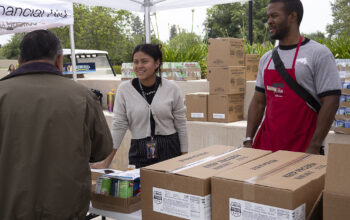The Los Angeles Department of Water and Power (LADWP) announced that the city is currently in Phase 2 of the Emergency Water Conservation Plan Ordinance.
Unlike the LADWP, the campus’ policy is not publicly summarized.
Since the beginning of the droughts of the 1990s, community college campuses have been adhering to a set of specific guidelines. LADWP also calls the guidelines of this ordinance “Watering Days,” which limit the amount of time allotted for commercial and residential irrigation.
“The policy is to adhere to the regulations imposed by LADWP,” Director of Facilities Paul Nieman replied in an email.
The regulations outlined in the ordinance prohibit uses for LADWP customers. Among the restrictions is a breakdown of non-watering days as well as restrictions for sports fields and large landscaping areas.
“We reduced the water use years ago, far above 20 percent,” instructor of Horticulture Len Markowitz said, “The ordinance is not fair for those of us that have already been conserving.”
Markowitz is not only an instructor, but is also a state licensed contractor, a state license pest control adviser and applicator, and a public works inspector in Simi Valley. He has been educating students, companies and organizations about conservation for several years.
For the past nine months he has been testing a new patent by Ray Ambrosini, called the Underground Moisture Control Grid. The grid is designed to be installed before landscaping.
“This is a great product for a new installation. It will help reduce water use,” Markowitz said.
The grid is made of panels that are placed four-to -six inches under the surface of the soil, plants and grass. The panels have liners that hold the moisture, allowing the water to percolate through four inch holes on it’s surface.
“Agriculturally, especially in California, the trend has been low-volume drip irrigation,” Director of the Pierce Farm Center Robert McBroom said.
Operating on its own funding, the Farm Center’s focus on conservation started at an economic level. McBroom’s team has been effectively managing its water consumption for the last ten years, using a drip irrigation system.
Drip irrigation or localized irrigation is a process that allows water to drip in a precise location. McBroom’s team analyzes the soil to determine how much time is needed to water. The distribution is then locally dispensed through a series of hoses and drip valves.
The valves have a drip zone that is centered in the direction of the roots, to minimize the Farm Center’s water consumption.
McBroom believes that education is the most important factor in water conservation. The Farm Center’s attractions are also designed to keep the community environmentally informed.
“I can probably water 2000 linear feet of tomatoes, for the same amount of water you use for your shower,” said McBroom, “You model by example. That’s the key.”
The Metropolitan Water District’s website “Be Water Wise,” provides financial incentives for businesses, agriculture, and institutions, who achieve their goals. With the rapid decline of our water resources and due to weather conditions, much of the State’s water supply has been depleted.
Gardner Than Ta is one of the landscapers on campus, who have been installing and working on a water control system for over two years. Currently the system is not ready for use.
“This is a big problem. Many of the aqueducts are less than half full. The drought is really serious.” Than Ta said.
It has been a challenge for campus gardeners to maintain watering cycles, due to low pressure issues. The crew has had to alternate the sprinkler systems, in order to irrigate within the restriction. The Gardening staff waters daily from 6 to 9 a.m. across the campus and only on weekdays.
“My boss Mr. Nieman gave us specific guidelines as to how to conserve water on campus,” Gardening Supervisor Thaun Vu said.
Paul Nieman also wrote in an email, that the college is working on a sustainable system. It would allow water to be collected at “The Pit” on campus, instead of allowing it to flow down to the LA River.
The Pit is the large open field, where the Pierce women’s soccer team hosts many of its home games and is located between Parking Lot 7 and the softball field.
Los Angeles Department of Water and Power – Ordinance & Codes buff.ly/X6PIRd
Be Water Wise – http://bewaterwise.com



